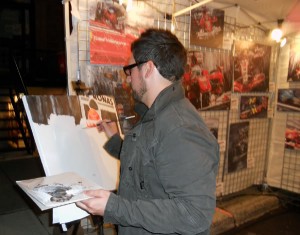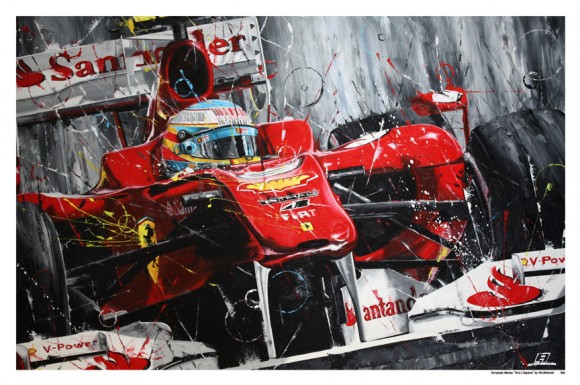Indy and Edmonton arts community look for common ground
Posted on July 23, 2011 By Rob Drinkwater Family, Front Slider, Visual Arts
Visual and dance artist Saski Aarts isn’t exactly warm towards the race, which takes place at City Centre Airport from July 22-24.
 For starters, she says she’s been woken up in past years by the mosquito-like sounds of the race cars even though she says she lives more than three kilometres from the track.
For starters, she says she’s been woken up in past years by the mosquito-like sounds of the race cars even though she says she lives more than three kilometres from the track.
But this year Race Week Edmonton, a new festival that’s intended to expand interest in the race outside the raceway gates, includes arts and musical events.
To Aarts’ delight, a last-minute addition to the festival schedule includes burlesque shows by New York-based Angie Pontani and the Pontani sisters that are running Thursday-Sunday at the Roxy Theatre.
The troupe will also perform a more family-friendly version of their act on the Race Week Edmonton main stage located on Rice Howard Way from Thursday to Saturday.
“For the first time, I’m going to something connected to the Indy,” says Aarts.
Tamara Fahlman, communications director for the Edmonton Indy, says race organizer Octane Motorsports wants the new festival to replicate the excitement and atmosphere that exists at the annual Formula 1 race the company also manages in Montreal.
“From Octane’s perspective, it’s not just about the race,” Fahlman explains. “We really wanted to bring the F-1 feel to Edmonton.”
“When we met with the mayor in the fall, he was admamant that he didn’t just want this to be about the track.”
Before last year, artists were mostly indifferent to the Indy. That morphed into bitterness in 2010 when Edmonton Folk Festival organizers expressed dismay that the race, which reportedly lost $9.2 million over 2008 and 2009, was approved for $821,250 in marketing funding from the two-year federal Marquee Tourism Events Program.
The race had also been approved the previous year for $399,314 from the program, while the Folk Festival was denied funding both years and had and hoped to use the cash to market itself in the U.S.
The Edmonton Fringe got $414,300 in 2009 but was also shut out in 2010.
Industry Minister Tony Clement said at the time that the funding was being limited to two events per city in each year. The other recipient in Edmonton in 2010 was the Edmonton Eskimos, which received $425,914 to market the 2010 Grey Cup.
“It just seems in this city, arts always take a back seat to sports,” says Wolfjunge, a dancer and fire performer, who rejects the argument that the majority of Edmonton’s population prefer sports.
“How many sporting events are there in the city? Compare that to the number of arts festivals. There are so many this time of year that they overlap.”
Aarts, meanwhile, says she’s skeptical about the value in economic spinoffs that Indy supporters claim it generates for the economy. She says arts festivals don’t get to lose as much money as the Indy has lost for so many years, yet they still bring value to the local economy.
“Do I agree with the Indy? When it seems to be coming at the cost of other truly grassroots festivals, I do not,” she says.
Dean Heuman, the head of marketing for Race Week Edmonton, notes that he and the other festival organizers are volunteers. He apologises for any shortcomings of the festival, noting it’s their first year and it had to be organized quickly because the Indy almost didn’t happen in 2011 due to negotiations between the city and Octane breaking down last year.
Heuman, who runs a public relations company with is wife, admits the festival is a little thin on the arts side. Until the burlesque show was added, the only arts offering on the schedule besides music was a decorating contest for soap box derby carts.
Still, he says music and cars have always gone well together and he hopes Race Week Edmonton will grow into something non-race fans can enjoy.
“There’s a lot of people who came down to the Grey Cup party in Churchill Square who didn’t buy tickets for the game and who were’t even football fans. They had a wonderful time celebrating the fact that we were hosting the Grey Cup,” Heuman said.
Some of the hostility that artsists and arts fans feel towards the Indy may stem from the belief that sports and art have nothing to do with each other, or that sports fans might consider arts spending a waste of money. In the online comments sections that followed news stories last year about the allocation federal tourism money to the Indy, a few race supporters suggested government money that was spent on the new Art Gallery of Alberta was excessive.
If there’s anyone who can identify with both artists and motorsports fans, it would be Montreal-based artist Arturo Rotondo, whose work appears on the official program for this year’s Indy.(That’s a print of his work, above.)
Rotondo, 32, began painting at age 12 and went on to pursue a career as a graphic artist. But a lifelong love of racing eventaully inspired him to take up a career painting the sport that he’d been watching with his family all his life.
Prints of his motorsports paintings, many of which he does as commissions from drivers or teams, will be available for sale at the track in Edmonton during the Indy. He’s also expanded to creating custom designs on helmets.
Rotondo compares the cars winding their way around the track to a ballet. He says art is about conveying mood and races are full of emotion, and sensation. There’s speed, roar, and the smell of gasoline.
In a way, he acts as an ambassador between arts and motor sports. Non-race fans who get dragged to the races with spouses see his prints and see beauty in racing. Race fans, meanwhile, admit to him that they weren’t fans of art, but the say they like his work.
“Race fans don’t really know they’re art fans and art fans don’t really know they’re race fans,” says Rotondo, whose younger brother manages the marketing of his work.
“We’re trying to get our view of motorsports to the world. One painting at a time.”












